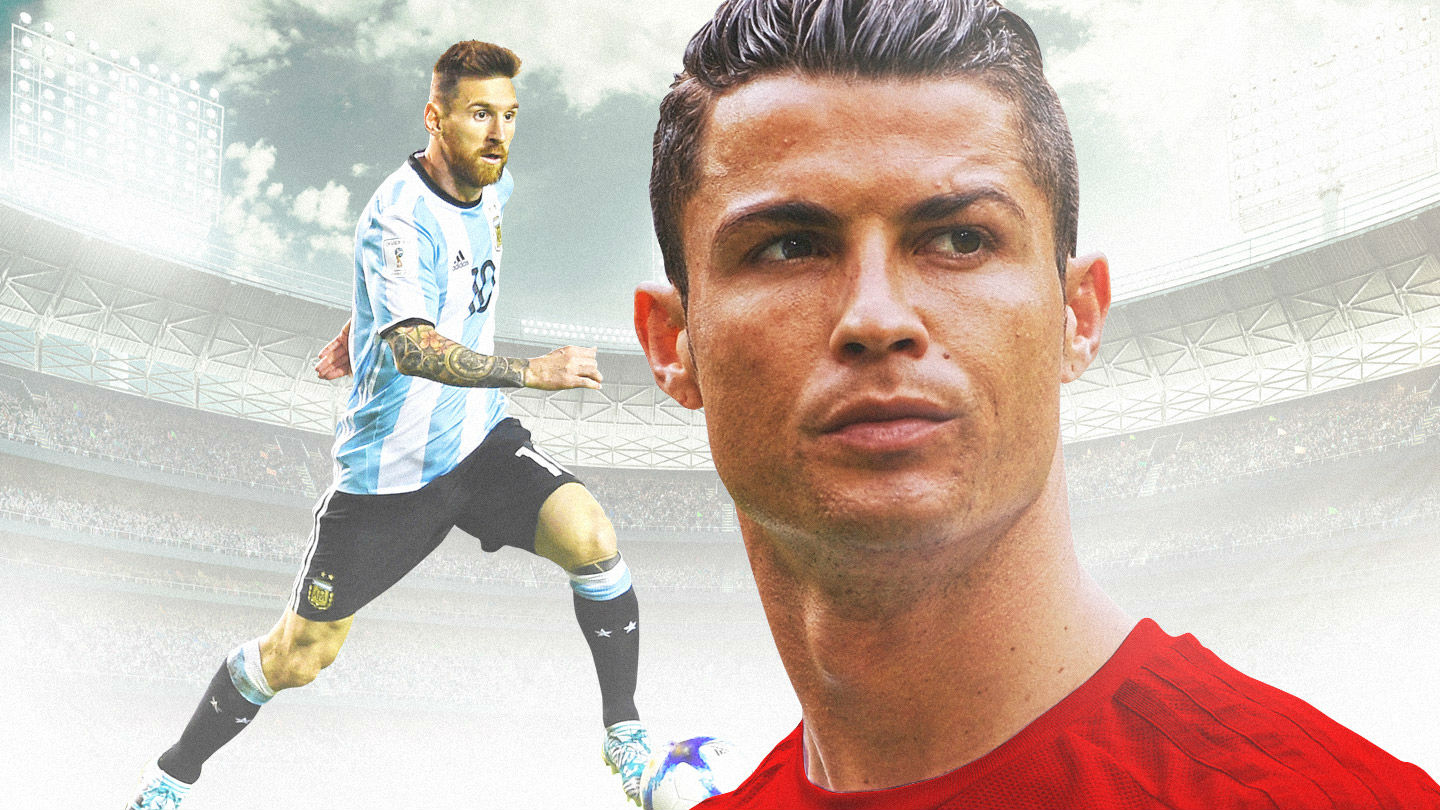Sportsnet soccer editor John Molinaro answers one of the world’s great sports debates by dissecting and illustrating each player’s strengths and weaknesses.
Below: The case for Lionel Messi.
(Click here if you prefer to read the Cristiano Ronaldo breakdown first.)
Soccer is the king of all sports in Argentina. It is the national pasttime, the national obsession.
The kids from the barrios and shantytowns of Buenos Aires, the country’s sprawling capital, as well as the bustling metropolises of Rosario and Cordoba, fill the streets and play on makeshift pitches from sunrise to sundown, honing their skills in pickup games in hopes of one day making it big.
A few do. But most don’t. But all of them aspire to follow in the footsteps of Diego Maradona, the country’s most famous athlete and one of the greatest soccer players of all-time. He led his country to World Cup glory in 1986.
Whenever a young soccer star emerges from the seemingly endless production line of Argentine talent, he is quickly labelled “the next Maradona.” Many have dared to ascend to the throne but only one man has done it.
It was Maradona, the king himself, who shortly after watching a Champions League match between FC Barcelona and Chelsea in 2006 boldly declared Lionel Messi as his heir apparent.
“I’ve seen the player who will inherit my place in Argentinian football and his name is Messi,” Maradona said. “He is beautiful to watch – my kind of player in our blue and white jersey. He’s a leader and is offering classes in beautiful football. He has something different to any other player in the world.”
Messi has played in three World Cups, but unlike Maradona, he has yet to win it. The Barcelona star will get another chance next month in Russia when he is expected to grace the sport’s biggest stage one last time.
But what makes Lionel Messi so special? How has he become, alongside Cristiano Ronaldo, the greatest player of his era, and amongst the best of all time?
Sportsnet takes an in-depth look at Messi’s game.
GOAL SCORING
Messi scores goals. Lots and lots and lots of goals – more than 600 for club and country during his career. At age 30, he’s already one of the most dangerous, prolific and consistent goal scorers the sport has ever known. He wastes few chances, rarely snatching at his shots. Instead, he waits for the goalkeeper to commit himself before sticking the knife in.
Messi joined Barcelona as a 13-year-old, continuing his soccer education at the club’s famous youth academy, La Masia. It was there that he refined his goal-scoring instincts, drawing plaudits from coaches and teammates, including Victor Vazquez. The Barcelona-born midfielder cut his teeth at La Masia, playing alongside Messi before graduating to the senior team for a brief spell. Today, Vazquez plays for Toronto FC in MLS, and he continues to marvel at his close friend’s goal-scoring exploits.
“He can do everything. Sometimes you expect he’s going to dribble to the right and then he turns to the left. He has many things to [influence] the game, many ways to score,” Vazquez told Sportsnet.
Nicknamed the La Pulga Atómica (“The Atomic Flea”), Messi is renowned for his agility and speed, and ability to evade defenders when he goes on one of his slalom-like, dribbling runs. He’s a left-footed genius who can score so many different ways.
Defenders often try to close down the space in front of him and tackle him as soon as he touches the ball. Sometimes it works, and it can seem like Messi is anonymous during a game. But he remains focused at all times, patiently waiting out defenders for the moment when they forget about him. That’s all he needs – just a split second, a tiny, sliver of space. Then he strikes, as Iran discovered to its peril at the 2014 World Cup when Messi scored an injury-time winner.
Teams try to gang up on him, using three or four players to box him into a tight space near the sidelines. This is when we see the master dribbler at his very best, taking opponents on in full flight, cutting in off the wing, leaving a trail of defenders in his wake as he heads towards goal and smashes a low piledriver past the goalkeeper.
Free kicks? Messi has mastered the art. He’s not the most accurate free kick-taker in the world, but he almost always hits the net, keeping goalkeepers guessing with his trademark curlers from long distances that dip and bend over the defensive wall, and sail into the back of the net.
Although not renowned for his aerial ability, the diminutive Argentine can generate a lot of power when he launches himself in the air to connect on a header, like he did when he majestically scored against Manchester United in the 2009 Champions League final.
DRIBBLING
This is the one area where Messi stands alone. Bluntly, he has no equal when the ball is at his feet. Not even Ronaldo. While the Portuguese is often guilty of slowing down the attack with his step overs and feints, Messi is ruthless in his attacking runs.
To be sure, he can juke and jive his way through defenders, his quick feet allowing him to escape tight spaces when surrounded and seemingly with no place to go. But he does it at top speed, with the ball glued to his left foot, always looking to up the tempo of the game, not decrease it. There is very little that is ornate about his dribbling.
There is an undeniable aesthetic quality to the way he dribbles around his defensive markers. But he’s not concerned about winning style points. He’s constantly thinking about carving out the most direct path towards the opponent’s net. Messi’s ability to beat a number of defenders in quick succession makes him almost unstoppable.
“When he is one against one, against a centre back or a defender, he has the ability to dribble past them and shoot to whatever side of the net he wants, [thus] making it much more difficult for the goalkeeper,” Vazquez said.
Perhaps Messi’s best piece of dribbling came in a 2007 La Liga match, when he slalomed his way through most of the Getafe team before scoring with a cool finish. The video of his majestic run instantly went viral, and drew comparisons to Diego Maradona’s epic “Goal of the Century” against England at the 1986 World Cup in Mexico.
Messi’s magnetic control of the ball wouldn’t count for much if not for his expert reading of the game. The Argentine’s mind is constantly churning, thinking three to four moves ahead, and instinctively looking for gaps and tiny crevices of space to exploit. He does this by keeping his head up, allowing him to survey the lay of the land and explore his options. It’s his awareness of all around him on the pitch that sets him up to be successful, to go on those dribbling runs for which he has become famous.
And he doesn’t need to constantly caress the ball to get where he’s going, either. He can be lethally economical in the way he moves the ball around, his first touch often sending him a good five yards clear of a defender. From there, he accelerates towards goal, and just a few touches later the ball is in the back of the net.

LOW CENTRE OF GRAVITY AND BALANCE
Comparisons with Maradona were inevitable ever since Messi burst onto the scene at Barcelona. Both played for the Catalan club, although Maradona did it ever so briefly during a two-season stint in the early 1980s, and both starred for Argentina’s national team.
There’s more to it than that, though. They played in different eras, but Messi and Maradona shared similarities in playing styles, both distinguishing themselves as deft left-footed dribblers who overcame their diminutive size en route to becoming global icons.
Messi boasts a wiry, thin frame, while Maradona was built more like a fire hydrant. But their relative same size (Messi stands five-feet-seven; Maradona was five-feet-five) means they both have a low centre of gravity. This allowed them to make quick and instant turns in one direction on the pitch, and ride out tackles by staying on their feet longer when challenged. Messi has rightly earned a reputation as one of the best dribblers in the history of the sport – he’s able to worm through tiny creases between defenders that few other players could even squeeze through.
As Willamette University science professor Stasinos Stavrianeas told The Atlantic in 2014, the “quicker stepping pattern [of short players] … makes them more elusive for the defender.”
When Maradona took Italy by storm following his move from Barcelona to Napoli, Serie A defenders soon learned the only way to knock the Argentine wizard off balance was by unmercifully hacking at his ankles. Messi has had to endure the same treatment for much of his career – the Argentine is so slight of foot that defenders routinely attempt to stop him by roughing him up and pulling him down.
“The easy way [to stop him] is to kick him and try foul him, but even sometimes when the defenders are kicking him, he’s really strong in his lower body, [so] he can react and continue. Most of the players when you do that to them, they fall down. Messi just continues. The easiest way to stop him is to foul him and bring him down,” Vazquez told Sportsnet.
THE VERDICT
For Messi, it’s all about his deep love of soccer. You’d never know that by his quiet, unassuming demeanor. While Maradona was an extrovert and a braggadocios showman, Messi is a man of few words, almost shy. He does his talking on the field.
Goal celebrations are often muted, emotion rarely shown. But underneath that reserved exterior rages a pure passion for soccer. It’s what drives Messi to be the best.
By all accounts, he’s still enjoying it, as evidenced by another La Liga championship and Spanish league scoring title with FC Barcelona this past season. At age 30, he’s still at the very top of his game, showing very little signs of slowing down. Win or lose next month in Russia, his place amongst the greatest players of all-time is assured.
But is he better than Ronaldo?
Each alone would be considered once-in-a-generation talents. And while it may seem unfair — or even impossible — to pick one over the other, this is sports, so where is the fun in staying neutral?
And since this exercise requires a choice, I’ll have to go with Messi.
The Argentinian is simply a more well-rounded player than Ronaldo. Messi is more of an orchestrator — for himself and his teammates. And while neither is known for his defensive prowess, this is another area where Messi holds a slight edge.
(Click here to read the full case for Ronaldo.)
And who knows? With the World Cup offering both men the opportunity to present new, emphatic arguments in their favour while performing on the world’s biggest soccer stage, this debate is far from over.
[polldaddy poll=10027610]



